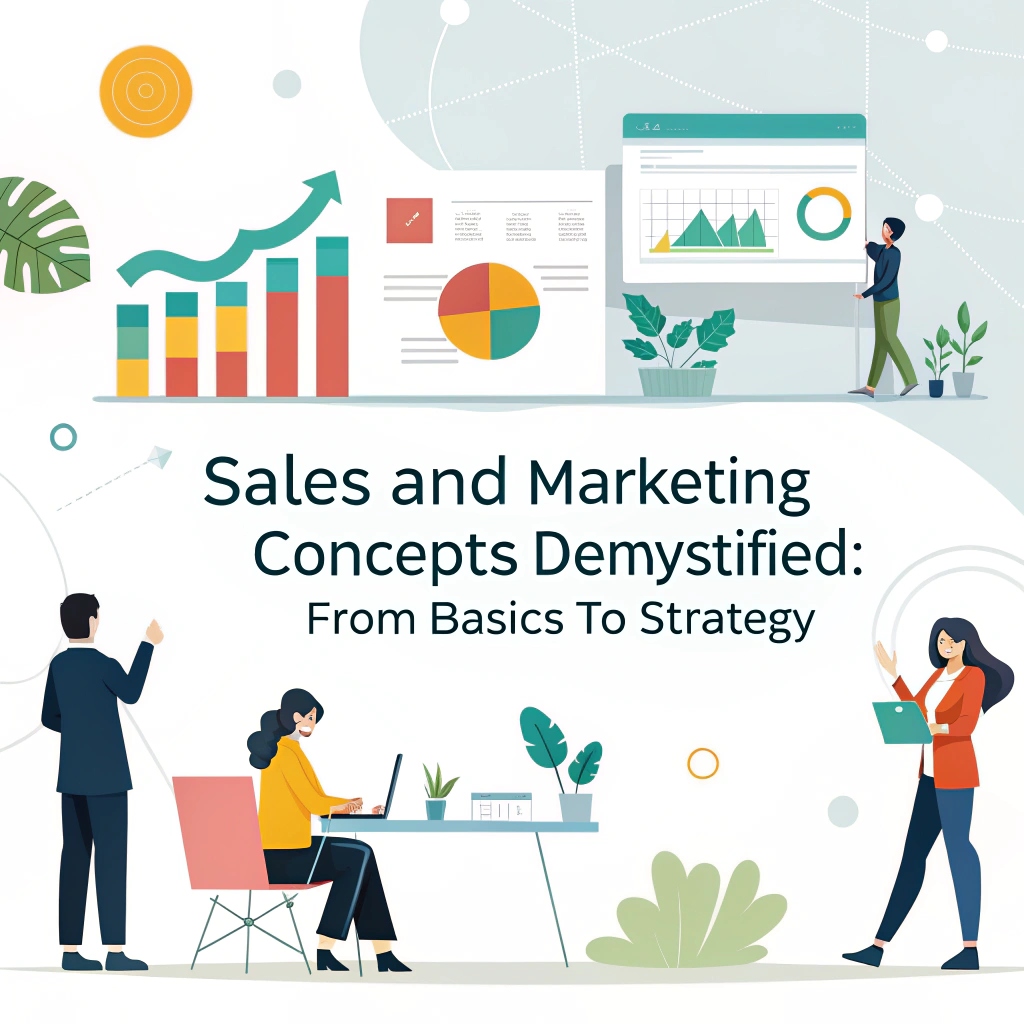
Introduction: Why Understanding Sales & Marketing Concepts Matters
In today’s business landscape, success doesn’t depend solely on great products. Instead, it hinges on how well you understand and apply the core sales and marketing concepts that drive buyer behavior, shape market perception, and convert leads into long-term customers. Whether you’re a startup founder, sales executive, marketing strategist, or freelancer—getting these fundamentals right is your roadmap to sustainable growth. This blog demystifies the most critical sales and marketing concepts—from the basics to advanced strategic implementation. We’ll explore how big brands use them, what tools amplify them, and how you can align them for real-world success.
Section 1: Core Concepts of Sales vs. Marketing – What’s the Difference?

Though they work together, sales and marketing have distinct roles:
| Aspect | Sales | Marketing |
|---|---|---|
| Objective | Convert leads into customers | Generate awareness and interest |
| Focus | Individual buyers | Market segments |
| Timeframe | Short-term (immediate conversions) | Long-term (brand building) |
| Tools | CRM, cold calls, meetings | SEO, ads, content, email |
Think of marketing as the magnet, and sales as the handshake.
Example: Apple
- Marketing: Emotional storytelling, ecosystem loyalty (“Think Different” campaigns)
- Sales: In-store product demos, upsells, Apple Genius support
Section 2: Foundational Sales Concepts

1. The Selling Concept
A traditional approach where businesses push products aggressively, assuming people will buy if they’re convinced enough.
- Example: Tele-sales calls promoting broadband packages
- When it works: In saturated, price-sensitive markets (e.g., retail, FMCG)
2. Product Selling vs. Conceptual Selling
- Product Selling: Focuses on features and benefits (e.g., “this phone has 8GB RAM”)
- Conceptual Selling: Focuses on solving problems (e.g., “this phone fits your digital lifestyle”)
Tip: Buyers don’t just buy what you sell—they buy why you sell it.
3. Direct & Consultative Selling
- Direct Selling: One-on-one approach (e.g., MLM, field sales, real estate)
- Consultative Selling: Long-term solutions via discovery, empathy, and customization
Section 3: Essential Marketing Concepts

1. The Marketing Concept
A customer-centric model where the goal is to understand needs and deliver value better than competitors.
- Example: Coca-Cola adapts flavors and packaging for local tastes worldwide
2. The Societal Marketing Concept
Goes beyond consumer satisfaction to consider societal welfare.
- Example: Patagonia’s campaigns on sustainability, urging people to “buy less”
3. The Holistic Marketing Approach
It integrates:
- Relationship Marketing
- Integrated Marketing (channels, message consistency)
- Internal Marketing (team alignment)
- Social Responsibility
Tip: Modern customers want brands that align with their values.
Section 4: Strategic Integration of Sales & Marketing

To truly thrive, sales and marketing must collaborate, not compete.
The Funnel Strategy: A Shared Model
- Awareness (Marketing-led): Ads, blogs, SEO
- Interest (Joint): Email nurturing, landing pages, lead magnets
- Decision (Sales-led): Demos, proposals, objection handling
- Action: Purchase
Tools to Align Teams:
| Tool | Purpose |
|---|---|
| HubSpot | Full-funnel marketing + sales CRM |
| Salesforce | Deep lead tracking, pipeline management |
| Notion / ClickUp | Sales-marketing playbooks |
| Canva / Visme | Shared content creation |
| Slack + Zapier | Collaboration and automation |
Section 5: Real-World Examples of Concepts in Action

Coca-Cola: Selling Happiness, Not Just Soda
- Marketing Concept: Universal storytelling (“Share a Coke”)
- Sales Execution: Mass retail partnerships and bundle deals
Tesla: Disrupting Through Conceptual Selling
- Marketing Concept: Zero paid advertising—relies on buzz and brand believers
- Sales Concept: Online, direct-to-consumer model with minimal touchpoints
Unacademy: Direct + Content-Driven Marketing
- Live sessions = Direct selling
- YouTube content = Organic inbound marketing
- Paid ads = Funnel automation
Section 6: Conceptual Selling as a Strategic Differentiator

Today’s buyers demand more than specs—they want meaning.
How Conceptual Selling Works:
- Understand the customer’s worldview
- Identify emotional and practical pain points
- Present your product as a solution, not just a thing
Industries Using Conceptual Selling Successfully:
- Life insurance
- SaaS startups
- Coaching and consulting
- Real estate (investment storytelling)
- EV & sustainable tech
Real-World Example: LIC Insurance Advisor
Instead of selling policies, a good LIC agent sells “peace of mind” and “secure futures.”
“Mr. Sharma, what will your child do if something happens to you?” This opens the door to life cover discussions more effectively than product specs.
Section 7: Building Strategy from Concept to Execution

1. Define Your Buyer Persona
Use:
- Google Analytics
- Meta Audience Insights
- LinkedIn Sales Navigator
- Surveys and Typeforms
2. Map Customer Pain Points
- Conduct interviews
- Read competitor reviews
- Use tools like AnswerThePublic or Quora
3. Develop a Message Matrix
Align:
- Need → “I need peace of mind”
- Product → “Term Insurance Plan”
- Message → “Secure your family’s future starting at ₹20/day”
4. Implement Through Funnels & CRM
- Create landing pages using Unbounce / Webflow
- Track via CRM (Zoho, Pipedrive, HubSpot)
- Run Facebook/Google Ads with pain-point targeting
Section 8: Top Tools for Sales & Marketing Success in 2025
| Category | Tool | Best For |
|---|---|---|
| CRM | HubSpot, Zoho, Salesforce | Tracking sales conversations |
| Marketing Automation | Mailchimp, Moosend, ActiveCampaign | Email & lead nurturing |
| Design | Canva, Visme, Pitch | Storytelling decks & social media |
| Funnels | ClickFunnels, Systeme.io | Lead generation |
| Ads | Google Ads, Meta Ads Manager | Paid awareness & retargeting |
| Analytics | Google Analytics, Hotjar | Website performance & behavior mapping |
Section 9: Mistakes to Avoid When Applying Concepts
| Mistake | Fix |
|---|---|
| Focusing only on product features | Highlight the problem you solve |
| Sales & marketing working in silos | Hold joint strategy sessions |
| Using outdated scripts | Personalize pitches with CRM data |
| Not measuring ROI | Use tools like UTM links, A/B testing |
| Ignoring after-sales experience | Implement follow-up emails, feedback forms |
Conclusion: Concepts Aren’t Just Theory—They’re Roadmaps
Sales and marketing concepts aren’t dusty textbook theories—they’re the frameworks behind every smart, scalable business today. By:
- Understanding customer psychology,
- Aligning your teams around a common buyer journey,
- And integrating tools that enhance automation and personalization,
you can build a strategy that doesn’t just sell—but connects, solves, and scales.
“When strategy meets empathy, sales become conversations—not transactions.” — Kundan Ranjan Tiwary, Founder of Sales LiftUp






